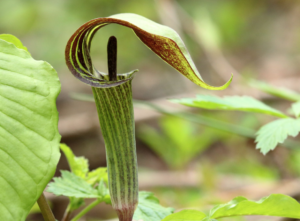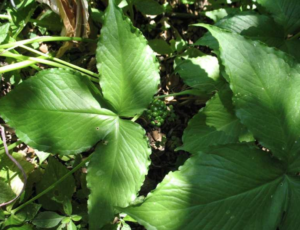Common Name: Jack-in-the-Pulpit, Bog Onion, Brown Dragon, Indian Turnip
Specific Name: Arisaema triphyllum
Known Occurrence at Taylor Point:
Map Areas: Woodlands 3A, Woodlands 3B, Beach 1E
Category: Native, Herbaceous Plant

Ecological Considerations:
Arisaema triphyllum is a herbaceous perennial that grows one to two feet high and is characterized by three-parted leaves and flowers growing within a spadix ( essentially a spike inflorescence which has small flowers growing on a fleshy stem), that is covered by a hood or spathe. The inflorescences are irregular in shape and commonly grow to a length of about 3 inches. They present tiny flowers of both sexes. In young plants most, if not all of the flowers are male. As the plants age and grow larger, the spadix produces more female flowers. The spadix itself is typically green with purple or brown stripes or it is greenish-yellow.
Jack-in-the-Pulpit flowers from April to June. Its aroma attracts flies which pollinate the flowers. Because the male flowers on a specific plant mature and die before the female flowers of that same plant mature, Jack-in-the-Pulpit is not a self-pollinating plant. Rather, the female flowers need to be pollinated by the male flowers of a different plant.
The fruits of the Jack-in-the-Pulpit are smooth, shiny green berries clustered on the spadix. They ripen in late summer and fall, turning a bright red color before the plants go dormant. Each berry produces 1 to 5 white to tan-colored seeds. If the seeds are freed from the berry they may germinate the next spring, producing a plant with a single rounded leaf. Seedlings need three or more years of growth before they become large enough to flower.
Jack-in-the-Pulpit grows from a corm. It commonly grows in moist, shady, seasonally wet woodland environments. Its roots contain calcium oxalate and are poisonous.
Map areas where this plant can be used for revegetation:
Propagation Mechanisms/Strategies for Encouraging its Establishment:
Jack-in-the-Pulpit propagates by root division or from seed. Seeds may be sown outside in late autumn, or the following spring with or without cold treatment. The seeds should not be allowed to dry out. They may not germinate for up to two years.
Cormlets can be separated from the parent corm in fall.
Best Planting Practices/Options and Pros and Cons of Options:
Key Issues Regarding its Ecology:
Associated Ecological Benefits:
Birds and mammals eat the berries of Jack-in-the-Pulpit.
Availability of Locally Sourced Seeds and Plants:
Case Studies of Native Plant Establishment Efforts/Lessons Learned:
Additional Photos:



Sources cited:
RI Wild Plant Society
Missouri Botanical Garden
Lady Bird Johnson Wildflower Center
Wiki Arisaema_triphyllum
Key Words:
Arisaema triphyllum
Jack-in-the-Pulpit
Bog Onion
Brown Dragon
Indian Turnip
Native
Herbaceous Plant
